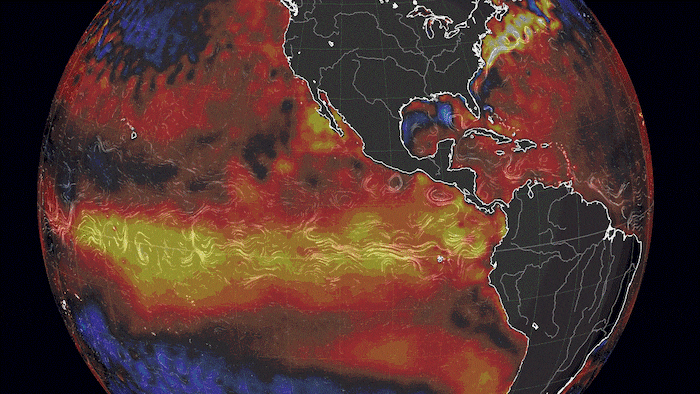Open in full screen mode The El Niño phenomenon seen from space. Radio-Canada Feature being tested
Speech synthesis, based on artificial intelligence, makes it possible to generate spoken text from 'a written text.
The expected return of the El Niño weather phenomenon after a hiatus of around eight years could be accompanied by a winter much hotter and drier in the Prairies, forecasters say.
But snowstorms and freezing temperatures are always possible, they qualify.
The El Niño phenomenon occurs when the temperature of the waters of the Pacific Ocean, along the equator, increases above normal. So the air above the waters warms and moves north.
In western Canada, this phenomenon modifies the configuration of the narrow band of air that separates cold weather to the north and milder weather to the south.
El Niño conditions, in general, give [the Prairies] warmer and drier winters than average, points out Terri Lang, meteorologist at Environment and Climate Change Canada.
According to meteorologists, the last El Niño phenomenon, which occurred during the winter of 2015-20116, was considered one of the strongest systems since data collection began around 1900.< /p>
At that time, Pacific Ocean temperatures rose more than 2°C above average in the Pacific region known as Niño 3.4
The phenomenon caused temperatures in the Prairies to be up to 4°C warmer than normal from December to February. It also led to an extreme humidity deficit.
The National Oceanic and Atmospheric Administration (NOAA) predicts a probability of 55 % for such an event to occur.
NOAA Climate Prediction Center Director David DeWitt says Niño 3.4 Pacific region temperatures are about 1.9°C warmer than average and are expected to increase ;intensify until December.
In addition, on November 9, NOAA stated that there is a 62% chance that' ;El Niño continues from April to June 2024.
However, Mr DeWitt cautions against relying solely on sea surface temperatures as an indicator, saying other seasonal weather patterns across the world could also impact the strength of El Niño.
It is possible that the El Niño phenomenon is relatively weak, but that it has relatively significant repercussions… or that x27;it is very strong, but with relatively modest repercussions, he emphasizes.
El Niño is the opposite of La Niña, a phenomenon that causes the waters of the Pacific Ocean to be colder than normal. La Niña generally brings more humidity and colder than average temperatures to the Prairies.
The last three winters have been marked by this phenomenon, according to NOAA.
If these forecasts are confirmed, Environment and Climate Change Canada meteorologist Terri Lang thinks the situation could be even more complicated in the Prairies after a record wildfire season and intense drought.
We had a last dry winter, a dry spring, a dry summer, recalls Ms. Lang.
According to the latest drought data, most of the Prairies are drier than normal and parts of southern Alberta are experiencing exceptional drought.
As of November 24, data from Environment Canada shows that many Prairie cities may already be feeling the effects of El Niño.
Calgary typically experiences an average daytime high of 3.4°C in November. This month it was 8.7°C.
In the cities of Edmonton, Saskatoon, Regina and Winnipeg, temperatures above the monthly average have also been recorded so far.
This month, Edmonton International Airport did not report snow, the first time since ;opening of the airport weather station in 1960.
In Saskatoon, snow is also rare, with about four centimeters at end of November, while the average snowfall in November is 13.4 centimeters.
The only exception is the city of Regina which Received about 17 centimeters so far in November, more than the monthly average of 13 centimeters.
With information from Ethan Williams

